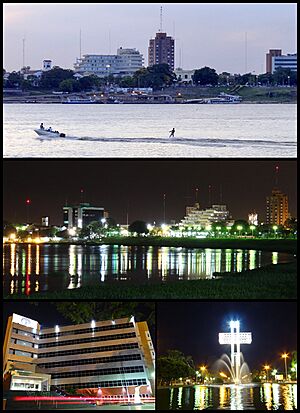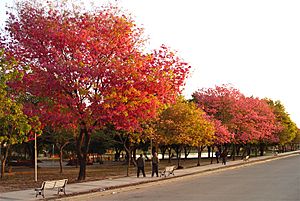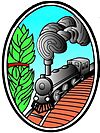Formosa, Argentina facts for kids
Quick facts for kids
Formosa
|
||
|---|---|---|

Collage of Formosa
|
||
|
||
| Country | ||
| Province | ||
| Department | Formosa | |
| Founded | April 8, 1879 | |
| Founded by | Luis Jorge Fontana | |
| Area | ||
| • City | 72,066 km2 (27,825 sq mi) | |
| Elevation | 57 m (187 ft) | |
| Population
(2010 census)
|
||
| • Estimate
({{{pop_est_as_of}}})
|
276,309 | |
| • Urban | 234,000 | |
| Demonym(s) | formoseño | |
| Time zone | UTC−3 (ART) | |
| CPA base |
P3600
|
|
| Dialing code | +54 370 | |
| Climate | Cfa | |
| Website | Official website: http://www.ciudaddeformosa.gob.ar/ | |
Formosa is an important city in Argentina. It is the capital of the Formosa Province. The city sits on the banks of the Paraguay River. Across the river is the town of Alberdi in Paraguay.
Formosa is about 1200 kilometers (746 miles) north of Buenos Aires. You can reach it by National Route 11. In 2010, about 234,000 people lived here. Formosa is a key center for the province's industries. These industries process goods from the area's natural resources. The city's port on the Paraguay River is vital for moving goods.
Some cool places to visit in Formosa include the Nuestra Señora del Carmen Cathedral and the Government House. You can also explore the Torelli Botanic Forest Garden. The Provincial History Museum is a great spot to learn about the past. Sports fans might like the Estadio Centenario football stadium. Nature lovers can visit the Guaicole fauna reserve or the Isla de Oro Island. Don't forget to walk along the Paraguay River shore or visit the Central Square named after José de San Martín.
Contents
History of Formosa
The land where Formosa now stands was first home to the Toba and Wichí (Mataco) native peoples. On April 8, 1879, Commander Luis Jorge Fontana founded the settlement. This settlement later became the capital of the National Territory of Chaco. This was from 1884 until June 15, 1955. That's when Formosa became a province.
The Formosa campus of the National University of the Northeast was started in 1988. It later became the National University of Formosa.
The name Formosa comes from an old Spanish word, fermosa. This word means "beautiful" (today it's hermosa). Spanish sailors in the 1500s used the name Vuelta Fermosa. This means "Beautiful Bend." They used it to describe a spot where the Paraguay River makes a turn. This turn is right in front of the city today. These sailors were looking for the legendary Sierra de la Plata, a mountain of silver.
Culture and Fun in Formosa
Formosa is very close to Paraguay. Because of this, its culture is more like Paraguay's than Buenos Aires's. The city has a relaxed and calm vibe. Young people often hang out on the Costanera. This is a recently fixed pathway along the Río Paraguay. It's a great place for art shows and has a fast-food restaurant. People also enjoy boliches, which are local clubs.
Formosa has several well-known cultural places. These include the Formosa Regional Historical Museum. There's also the Juan Pablo Duffard Historical Museum, which is a National Historic Monument. You can also visit the Qomp Toba Artisanal Museum. The Oscar Albertazzi Arts Institute is another important spot.
Since the 1970s, more people from Argentina have visited Formosa in winter. After 2002, when the peso currency changed value, more international tourists started coming too. Formosa has several nice hotels. The city's main sports venue is the Estadio Don Carlos Antonio Romero. It can hold 23,000 people and is mostly used for association football.
Festivals and Celebrations
Formosa celebrates its patron saint, Our Lady of Carmen (Nuestra Señora del Carmen), on July 16. The celebrations happen in the main Plaza San Martín. You can see the traditional pericón dance. There are also stalls selling food and balloons.
Other fun events include the Fiesta del Río in November. Carnaval is celebrated on weekends in February. The city also celebrates the Día de la Fundación de Formosa (Founding Day of Formosa) in April.
Getting Around Formosa
Formosa is located in the Argentine Littoral region. It is well connected to the rest of Argentina. Most people travel to and from Formosa using these ways:
- The Formosa Bus Terminal Station handles many passengers all year. Buses go to places near and far. Many national and international bus companies operate here. Common destinations include Buenos Aires, Rosario, Corrientes, Resistencia, Córdoba, Mendoza, Posadas, Salta, and Clorinda-Asunción.
- The El Pucú Airport (FMA/SARF) is 7 kilometers (4.3 miles) south of the city. It has charter flights and regular flights to Buenos Aires.
The General Belgrano Railway is not running trains anymore. Near the port, its tracks were removed. The old station building is now a museum. The sheds where trains were fixed are now a big fair.
- The city also has modern Public and Semi-public Transportation. These units have air conditioning and Wi-Fi. There are also taxi and remis (private car hire) services.
If you are driving from Buenos Aires, you can take National Route A011, National Route 86, and National Route 12.
Formosa's Geography and Climate

Formosa has a humid subtropical climate. This type of climate is called Cfa by the Köppen classification. Formosa's climate is one of the hottest and most humid in Argentina.
Winters are usually mild, and air frosts are very rare. Summers are hot and humid. During very hot periods, temperatures can go above 40°C (104°F). Temperatures have even gone above 35°C (95°F) in every season.
Summers are long, hot, and sticky. Most days are between 30°C and 35°C (86°F and 95°F). Temperatures up to 38°C (100°F) are common. Nights are usually between 20°C and 25°C (68°F and 77°F). Cooler weather arrives by late April.
Winters are warm. Highs average around 22°C (72°F), and lows average around 12°C (54°F). The weather can change quickly. Sometimes, hot winds from the north bring temperatures between 25°C and 30°C (77°F and 86°F). Nights are mild, around 15°C (59°F). Other times, cold winds from the south bring drizzly, cold weather. Temperatures might stay around 10°C to 15°C (50°F to 59°F) for a day or two. This can feel quite cold because of the humidity and wind. After that, skies clear, and nights are cold (2°C to 7°C / 36°F to 45°F). Days become pleasant at 15°C to 20°C (59°F to 68°F).
Light frost can happen in Formosa, especially outside the city. But air temperatures rarely drop below 0°C (32°F). This happens only every few years. The lowest temperature ever recorded was -2.5°C (27.5°F) on July 29, 2021. The highest was 43.7°C (110.7°F) on October 17, 2014.
Rain can happen all year, but summer is usually the wettest season. Thunderstorms can be strong. They often have lots of lightning, powerful winds, and heavy rain.
| Climate data for Formosa International Airport (1991–2020, extremes 1963–present) | |||||||||||||
|---|---|---|---|---|---|---|---|---|---|---|---|---|---|
| Month | Jan | Feb | Mar | Apr | May | Jun | Jul | Aug | Sep | Oct | Nov | Dec | Year |
| Record high °C (°F) | 43.0 (109.4) |
42.8 (109.0) |
42.0 (107.6) |
38.0 (100.4) |
37.0 (98.6) |
34.0 (93.2) |
34.1 (93.4) |
39.6 (103.3) |
42.4 (108.3) |
43.7 (110.7) |
42.0 (107.6) |
43.5 (110.3) |
43.7 (110.7) |
| Mean daily maximum °C (°F) | 34.1 (93.4) |
33.0 (91.4) |
31.7 (89.1) |
28.6 (83.5) |
24.5 (76.1) |
22.8 (73.0) |
22.7 (72.9) |
25.4 (77.7) |
27.2 (81.0) |
29.5 (85.1) |
30.9 (87.6) |
33.0 (91.4) |
28.6 (83.5) |
| Daily mean °C (°F) | 27.7 (81.9) |
26.9 (80.4) |
25.6 (78.1) |
22.7 (72.9) |
19.0 (66.2) |
17.3 (63.1) |
16.4 (61.5) |
18.3 (64.9) |
20.4 (68.7) |
23.4 (74.1) |
24.8 (76.6) |
26.9 (80.4) |
22.5 (72.5) |
| Mean daily minimum °C (°F) | 22.5 (72.5) |
22.0 (71.6) |
20.6 (69.1) |
18.0 (64.4) |
14.6 (58.3) |
13.1 (55.6) |
11.5 (52.7) |
12.7 (54.9) |
14.7 (58.5) |
18.2 (64.8) |
19.2 (66.6) |
21.4 (70.5) |
17.4 (63.3) |
| Record low °C (°F) | 12.6 (54.7) |
11.0 (51.8) |
7.7 (45.9) |
4.9 (40.8) |
−0.1 (31.8) |
−0.8 (30.6) |
−2.5 (27.5) |
−2.3 (27.9) |
1.7 (35.1) |
5.3 (41.5) |
8.0 (46.4) |
9.1 (48.4) |
−2.5 (27.5) |
| Average precipitation mm (inches) | 163.5 (6.44) |
135.6 (5.34) |
138.2 (5.44) |
159.6 (6.28) |
110.1 (4.33) |
60.3 (2.37) |
41.0 (1.61) |
34.8 (1.37) |
74.8 (2.94) |
150.3 (5.92) |
159.9 (6.30) |
178.4 (7.02) |
1,406.5 (55.37) |
| Average precipitation days (≥ 0.1 mm) | 8.7 | 8.7 | 8.0 | 8.5 | 8.2 | 6.7 | 5.1 | 4.8 | 7.1 | 10.1 | 8.9 | 9.2 | 94.0 |
| Average relative humidity (%) | 71.5 | 74.2 | 76.4 | 78.9 | 81.2 | 81.0 | 76.4 | 70.3 | 69.3 | 72.4 | 71.1 | 71.4 | 74.5 |
| Mean monthly sunshine hours | 275.9 | 228.8 | 226.3 | 198.0 | 186.0 | 153.0 | 189.1 | 195.3 | 183.0 | 213.9 | 255.0 | 269.7 | 2,574 |
| Mean daily sunshine hours | 8.9 | 8.1 | 7.3 | 6.6 | 6.0 | 5.1 | 6.1 | 6.3 | 6.1 | 6.9 | 8.5 | 8.7 | 7.0 |
| Percent possible sunshine | 66 | 65 | 60 | 58 | 60 | 54 | 58 | 52 | 52 | 59 | 64 | 67 | 60 |
| Source 1: Servicio Meteorológico Nacional | |||||||||||||
| Source 2: NOAA (percent sun 1961–1990) | |||||||||||||
Sister Cities
Formosa has special connections with other cities around the world. These are called "sister cities."
 Asunción, Paraguay
Asunción, Paraguay Bella Unión, Uruguay
Bella Unión, Uruguay
Sports in Formosa
The Aborigen Rugby Club is a rugby union club from Formosa. It was started in 1993.
Notable People
Many talented people come from Formosa. Here are some of them:
|
|
Images for kids
-
Formosa skyline from the Paraguay River
See also
 In Spanish: Formosa (ciudad) para niños
In Spanish: Formosa (ciudad) para niños










